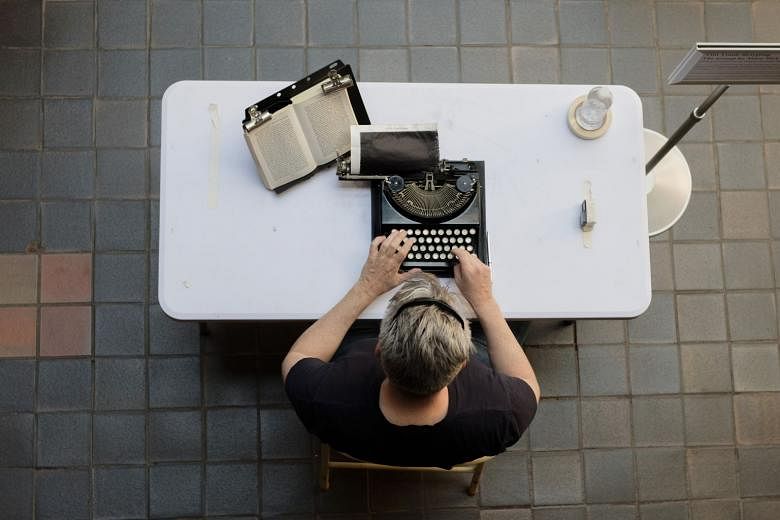POUGHKEEPSIE (New York) • Like a writer, Tim Youd got distracted. He did not notice that the paper was in wrong until he had typed "Herconfidencefledasshe".
A writer would have put spaces between the words, but Youd is not a writer. He is a performance artist who retypes famous novels, word for word, with no spaces - lineafterlineafterline,likethis.
And he does so on old typewriters like the ones the authors themselves used. Youd, 50, has retyped 55 novels so far. He is aiming for 100.
He has typed A Farewell To Arms in Piggott, Arkansas, where Ernest Hemingway wrote much of it; and The Sound And The Fury in William Faulkner's hometown, Oxford, Mississippi. He has typed Jack Kerouac's Big Sur in - where else? - Big Sur, California.
His 56th novel brought him here, to the campus of Vassar College. Last week, he began typing The Group, the 1963 bestseller about eight classmates from Vassar. It made Mary McCarthy, Vassar class of 1933, famous and also rich. Looking back on the 50th anniversary of its publication, Vanity Fair magazine described The Group as "shocking, titillating and acid-laced" and said: "Everyone loved Chapter Two."
Ah, Chapter Two. It described, in considerable detail, the first time one of the eight had sex.
Vassar is different from what it was in McCarthy's day - among other things, Vassar has admitted men since 1969. But Youd decided that The Group was just the thing to type on the Vassar campus and not just for its references to campus landmarks. Or its potential as a history lesson for undergraduates of the laptop-and-cellphone age who have never touched a carriagereturn lever or heard the bell ring close to the end of a line.
"Every novel has its flaws," he said. "This one, the difficulty is who's who. That many characters is a lot to stage-manage." McCarthy, he said, "does try, and usually succeeds".
Unlike a writer turning out double-spaced page after double-spaced page, Youd was typing a single single-spaced sheet of paper. That one page will contain the entire novel. By the time he reaches Page 487 and the last two words of The Group - "New York" - the page will be an inky, illegible mess.
"I'm coming at this from the perspective of the visual artist who's interested in how text and literature manifest themselves in a visual way," he said.
He is a two-finger typist - "me and Raymond Chandler," he said with a chuckle - but said he did not know how many words per minute he could bang out. "I'm more like a pages-per-hour guy," he said. "I generally have to get 25 pages done in a day."
Five pages an hour is a good pace, he said.
The typewriter this day was a Remington portable from the late 1920s or early 1930s that he said was just like the machine McCarthy owned when she wrote The Group. He bought it on eBay.
"It's very primitive," he said. "It's a pretty unsubstantial machine, compared with where typewriters got to."
He said he had read The Group before he typed the first word - which, for the record, was "It" - and he admitted to making mistakes as he went along. "Yeah, probably one a line," he said. "I just keep chugging along. I'm earnestly attempting to retype every word, but it's an exercise in good reading, not good typing."
Youd has typed on authors' actual typewriters. In London to retype John Kingsley Orton's plays, he did a page on Orton's own machine. But he said he would not do a whole novel on a machine that had belonged to an author.
"I'm jamming a beat-up page through there," he said. "When it gets all gunked up, I make a mess out of the typewriter."
This is why he has back-up typewriters. "I always have two of the same make and model," he said, adding that when nothing is available on eBay, "I have a couple of guys out there in the typewritercollecting world and I turn to them".
The first novel he retyped was Fear And Loathing In Las Vegas by Hunter S. Thompson. "The reason I chose him was he typed out The Sun Also Rises and The Great Gatsby to learn how to write fiction early in his writing career," he said.
NYTIMES

